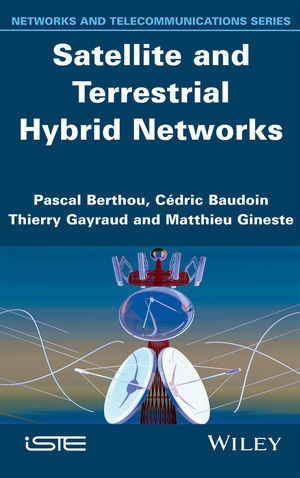En savoir plus
This book offers the reader the keys for a successful understanding, integration and usage of satellite systems in addition to next generation terrestrial networks. The DVB-S2/RCS system is used to illustrate the integration challenges. The presentation uses a system approach, i.e. it tackles the terrestrial and satellite telecommunication systems' complexity with a high level approach, focusing on the systems' components and on their interactions. Several scenarios present the different paths that can be followed for the integration of satellite systems in terrestrial networks. Quality of Service management techniques in terrestrial and satellite systems and the solutions to help them to interoperate are provided. Inter-system mobility solutions and performance problems are then addressed. The solutions proposed in this book have been developed within the framework of European and French funded research projects and tested with simulated or real testbeds.
Table des matières
ACKNOWLEDGMENTS ix
FOREWORD xi
Patrick GÉLARD
LIST OF ACRONYMS xiii
INTRODUCTION xxiii
CHAPTER 1. SATELLITE AND TERRESTRIAL HYBRID NETWORKS 1
1.1. Designing satellite and terrestrial hybrid networks 1
1.2. Hybrid scenarios 2
1.2.1. Network architecture: integration of hybrid networks 4
1.2.2. Tight coupling integration: an integrated approach 5
1.2.3. Gateway integration 7
1.2.4. Loose coupling integration 8
1.3. Case study: loose coupling integration 9
1.3.1. Use case and user profile 9
1.3.2. Proposal of a scenario 9
1.3.3. Profile of mobile users 11
1.4. Conclusion 12
CHAPTER 2. QUALITY OF SERVICE ON NEXTGENERATION TERRESTRIAL NETWORKS 15
2.1. IETF approach 16
2.1.1. Network level 16
2.1.2. Transport level 29
2.1.3. Session and application levels 32
2.1.4. QoS signaling 37
2.2. ITU-NGN approach 45
2.2.1. Principles 45
2.2.2. Transport stratum 47
2.2.3. Service stratum 49
2.2.4. Management plan 50
2.3. Conclusion 50
CHAPTER 3. QUALITY OF SERVICE IN DVB-S/RCS SATELLITE NETWORKS 53
3.1. Bi-directional satellite access systems 54
3.1.1. Overview 54
3.2. The DVB-S standard and the IP support 59
3.2.1. The DVB-S standard 60
3.2.2. Access method 63
3.2.3. IP encapsulation method over DVB-S 63
3.3. The DVB-S2 standard 67
3.3.1. Coding and modulations 67
3.3.2. Encapsulation 69
3.4. The DVB-RCS standard 70
3.4.1. Access method: MF-TDMA 71
3.4.2. Signaling in a DVB-RCS/S System 74
3.4.3. Connections 78
3.5. DVB-RCS2 79
3.5.1. Coding and modulation 79
3.5.2. Access techniques 79
3.5.3. Encapsulation 80
3.5.4. QoS architecture and PEP 80
3.6. QoS architecture in DVB-S/RCS satellite access networks 80
3.6.1. The various stakeholders in the satellite network 81
3.6.2. The SatLabs architectural model 82
3.6.3. The BSM architectural model based on IP 89
3.7. Conclusion 96
CHAPTER 4. INTEGRATION OF SATELLITES INTO IMS QOS ARCHITECTURE 97
4.1. IMS architecture 97
4.1.1. COPS and DIAMETER messages 99
4.2. IMS QoS architecture 100
4.2.1. IMS QoS in a GPRS: UMTS network 103
4.2.2. IMS QoS in an asymmetric digital subscriber line (ADSL) network 106
4.3. IMS QoS signaling 107
4.3.1. Authorization of QoS resources 108
4.3.2. Reservation of QoS resources with a local service policy 110
4.3.3. Approval of commitments of authorized resources 110
4.3.4. Deleting commitments of authorized resources 112
4.3.5. Revocation of a QoS resource authorization 112
4.3.6. Indication of a PDP context deletion 113
4.3.7. Authorization for the modification of the PDP context 115
4.4. Inclusion of IMS QoS in the satellite segment 116
4.4.1. "System" hypothesis 116
4.4.2. IMS satellite integration: transparent approach 117
4.4.3. IMS satellite integration: integrated star approach 118
4.4.4. IMS satellite integration: integrated mesh approach 119
4.5. Toward a unified next-generation network (NGN) QoS architecture 120
4.5.1. Transparent integration scenario 120
4.5.2. Star integration scenario 125
4.5.3. Mesh integration scenario 127
4.6. SATSIX project 130
4.7. Conclusion 132
CHAPT
A propos de l'auteur
Pascal Berthou is associate professor at the Toulouse University of Sciencea and a researcher at Laboratory for the Analysis and the Architecture of Systems of the French National Center for Scientific Research (LAAS-CNRS), Toulouse, France.
Résumé
This book offers the reader the keys for a successful understanding, integration and usage of satellite systems in addition to next generation terrestrial networks. The DVB-S2/RCS system is used to illustrate the integration challenges. The presentation uses a system approach, i.e.

